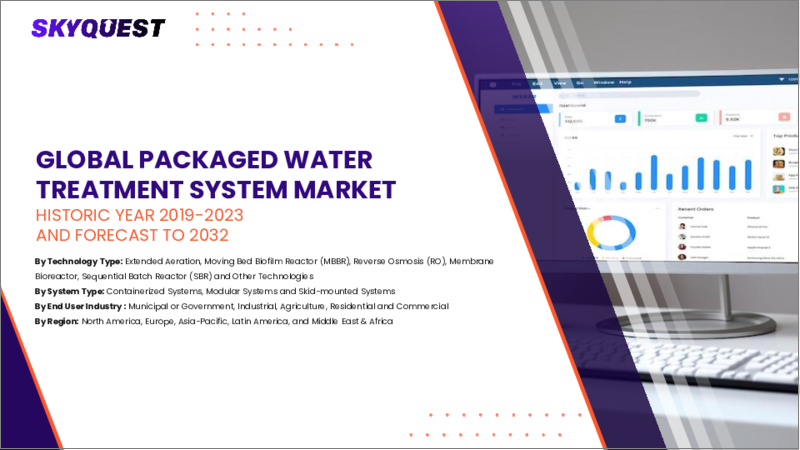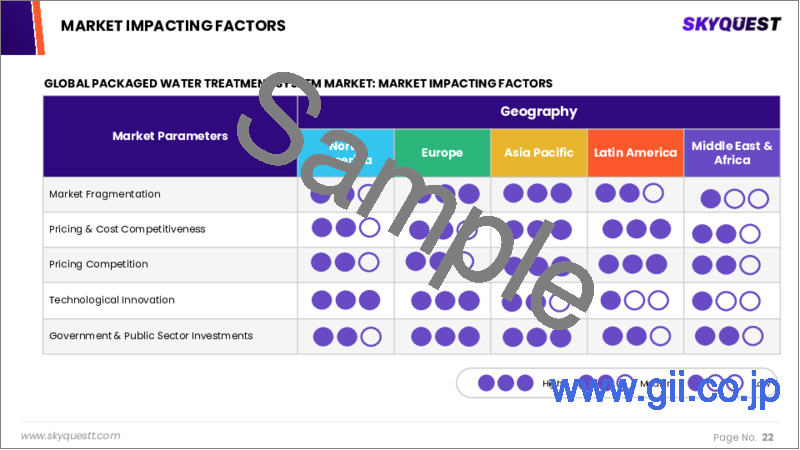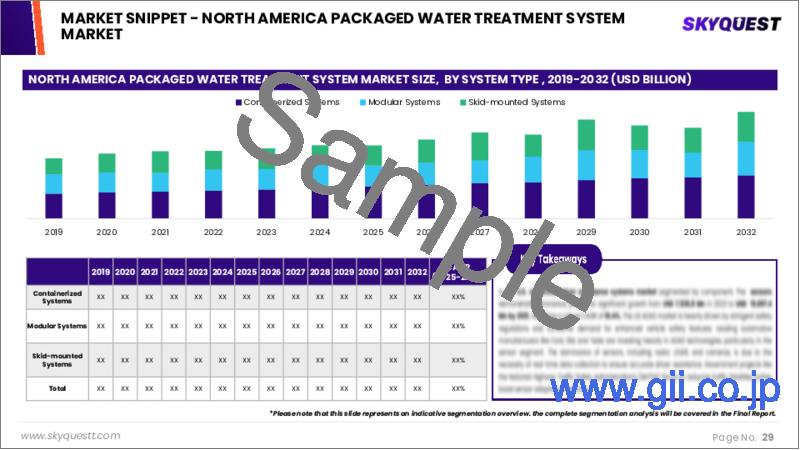|
|
市場調査レポート
商品コード
1623690
パッケージ型水処理システムの市場規模、シェア、成長分析、技術タイプ別、用途別、地域別 - 産業予測、2025~2032年Packaged Water Treatment System Market Size, Share, Growth Analysis, By Technology Type, By Application, By Region - Industry Forecast 2025-2032 |
||||||
|
|||||||
| パッケージ型水処理システムの市場規模、シェア、成長分析、技術タイプ別、用途別、地域別 - 産業予測、2025~2032年 |
|
出版日: 2024年12月27日
発行: SkyQuest
ページ情報: 英文 157 Pages
納期: 3~5営業日
|
全表示
- 概要
- 目次
パッケージ型水処理システム市場規模は2023年に241億米ドルと評価され、2024年の271億米ドルから2032年には570億4,000万米ドルに成長し、予測期間(2025-2032年)のCAGRは10.4%で成長する見通しです。
世界のパッケージ型水処理システム市場は、さまざまな分野で清潔で安全な水への需要が高まっていることを背景に、堅調な拡大を見せています。これらのコンパクトな設計済みユニットは、住宅、商業、工業、自治体など様々な用途に対応しており、河川、湖沼、地下水から供給される水に対する多様なニーズに対応しています。主な市場促進要因には、人口増加、都市化、工業化などがあり、これらすべてが効率的な水処理ソリューションへの需要を高めています。水質と安全性に関する政府の厳しい規制は、市場の成長軌道をさらに強化します。しかし、高額な初期設備投資、運用コスト、多数のプレーヤーによる競合情勢などの課題も残っています。メーカー各社は効率向上のための技術革新に積極的に取り組んでおり、それによって競争が激化し、持続可能な水ソリューションに対する消費者の多様なニーズに応えています。
目次
イントロダクション
- 調査の目的
- 調査範囲
- 定義
調査手法
- 情報調達
- 二次データと一次データの方法
- 市場規模予測
- 市場の前提条件と制限
エグゼクティブサマリー
- 世界市場の見通し
- 供給と需要の動向分析
- セグメント別機会分析
市場力学と見通し
- 市場概要
- 市場規模
- 市場力学
- 促進要因と機会
- 抑制要因と課題
- ポーターの分析
主な市場の考察
- 重要成功要因
- 競合の程度
- 主な投資機会
- 市場エコシステム
- 市場の魅力指数(2024年)
- PESTEL分析
- マクロ経済指標
- バリューチェーン分析
- 価格分析
- 技術の進歩
- 規制情勢
パッケージ型水処理システム市場規模:技術タイプ別
- 市場概要
- 拡張エアレーション
- 移動床バイオフィルムリアクター
- 逆浸透
- 膜バイオリアクター
- 連続バッチ反応器
- その他のテクノロジー
パッケージ型水処理システム市場規模:用途別
- 市場概要
- 都市下水治療
- 産業廃水治療
- 飲料水治療
- その他
パッケージ型水処理システム市場規模
- 北米
- 米国
- カナダ
- 欧州
- ドイツ
- スペイン
- フランス
- 英国
- イタリア
- その他欧州地域
- アジア太平洋地域
- 中国
- インド
- 日本
- 韓国
- その他アジア太平洋地域
- ラテンアメリカ
- ブラジル
- その他ラテンアメリカ地域
- 中東・アフリカ
- GCC諸国
- 南アフリカ
- その他中東・アフリカ
競合情報
- 上位5社の比較
- 主要企業の市場ポジショニング(2024年)
- 主な市場企業が採用した戦略
- 市場の最近の動向
- 企業の市場シェア分析(2024年)
- 主要企業の企業プロファイル
- 会社概要
- 製品ポートフォリオ分析
- セグメント別シェア分析
- 収益の前年比比較(2022-2024)
主要企業プロファイル
- Veolia Environnement(France)
- SUEZ(France)
- Xylem Inc.(United States)
- Pentair plc(United States)
- Ecolab Inc.(United States)
- Kurita Water Industries Ltd.(Japan)
- Kemira Oyj(Finland)
- Solenis LLC(United States)
- SNF Group(France)
- Aquatech International LLC(United States)
- WesTech Engineering Inc.(United States)
- Smith & Loveless Inc.(United States)
- Evoqua Water Technologies Corp.(United States)
- Parker-Hannifin Corporation(United States)
- The York Water Company(United States)
- American Water Works Company, Inc.(United States)
- California Water Service Group(United States)
- Middlesex Water Company(United States)
- SJW Group(United States)
- Veolia Water Technologies(France)
結論と推奨事項
Packaged Water Treatment System Market size was valued at USD 24.10 Billion in 2023 and is poised to grow from USD 27.10 Billion in 2024 to USD 57.04 Billion by 2032, growing at a CAGR of 10.4% during the forecast period (2025-2032).
The global packaged water treatment system market is witnessing robust expansion driven by the rising demand for clean, safe water across multiple sectors. These compact, pre-engineered units cater to various applications, including residential, commercial, industrial, and municipal, addressing the diverse needs for water sourced from rivers, lakes, and groundwater. Key market drivers include population growth, urbanization, and industrialization, all of which escalate the demand for efficient water treatment solutions. Stringent government regulations regarding water quality and safety further enhance the market's growth trajectory. However, challenges such as high initial capital investment, operational costs, and a competitive landscape with numerous players persist. Manufacturers are actively innovating to improve efficiency, thereby intensifying competition and meeting diverse consumer needs for sustainable water solutions.
Top-down and bottom-up approaches were used to estimate and validate the size of the Packaged Water Treatment System market and to estimate the size of various other dependent submarkets. The research methodology used to estimate the market size includes the following details: The key players in the market were identified through secondary research, and their market shares in the respective regions were determined through primary and secondary research. This entire procedure includes the study of the annual and financial reports of the top market players and extensive interviews for key insights from industry leaders such as CEOs, VPs, directors, and marketing executives. All percentage shares split, and breakdowns were determined using secondary sources and verified through Primary sources. All possible parameters that affect the markets covered in this research study have been accounted for, viewed in extensive detail, verified through primary research, and analyzed to get the final quantitative and qualitative data.
Packaged Water Treatment System Market Segmental Analysis
Global Packaged Water Treatment System Market is segmented by technology type, application and region. Based on technology type, the market is segmented into extended aeration, moving bed biofilm reactor, reverse osmosis, membrane bioreactor, sequential batch reactor and other technologies. Based on application, the market is segmented into municipal wastewater treatment, industrial wastewater treatment, drinking water treatment and others. Based on region, the market is segmented into North America, Europe, Asia Pacific, Latin America and Middle East & Africa.
Driver of the Packaged Water Treatment System Market
The Packaged Water Treatment System market is significantly driven by the enforcement of stringent water quality regulations set forth by governments and regulatory agencies. These regulations are designed to safeguard water quality and ensure public health, leading to a heightened demand for effective water treatment solutions across numerous industries. As organizations seek to adhere to these compliance requirements, the adoption of packaged water treatment systems becomes essential. This growing need for reliable water treatment solutions not only supports regulatory compliance but also underscores the commitment of various sectors to provide safe and clean water to consumers and communities alike.
Restraints in the Packaged Water Treatment System Market
Restraints in the Packaged Water Treatment System market primarily stem from considerable operational and maintenance expenses. Beyond the initial capital investment, the ongoing costs associated with these systems can be substantial, encompassing energy usage, routine servicing, replacement of essential consumables, and the disposal of waste materials. Such recurring financial obligations may deter potential users, especially in small-scale applications where budget constraints are tighter. This challenge can inhibit wider acceptance and integration of these systems, making it crucial for stakeholders to address these cost concerns to improve market uptake and ensure more sustainable water management solutions.
Market Trends of the Packaged Water Treatment System Market
The Packaged Water Treatment System market is witnessing a prominent trend towards sustainability, as companies increasingly prioritize eco-friendly and energy-efficient solutions. Innovations aimed at reducing energy consumption, minimizing chemical usage, and generating less waste are becoming essential features that attract environmentally conscious end-users. This shift not only reflects heightened consumer awareness but also aligns with global initiatives to conserve water resources and mitigate environmental impact. As regulatory frameworks tighten around sustainability, manufacturers are compelled to develop advanced technologies that meet these demands, positioning sustainability as a key driver for growth in the Packaged Water Treatment System market moving forward.
Table of Contents
Introduction
- Objectives of the Study
- Scope of the Report
- Definitions
Research Methodology
- Information Procurement
- Secondary & Primary Data Methods
- Market Size Estimation
- Market Assumptions & Limitations
Executive Summary
- Global Market Outlook
- Supply & Demand Trend Analysis
- Segmental Opportunity Analysis
Market Dynamics & Outlook
- Market Overview
- Market Size
- Market Dynamics
- Drivers & Opportunities
- Restraints & Challenges
- Porters Analysis
- Competitive rivalry
- Threat of substitute
- Bargaining power of buyers
- Threat of new entrants
- Bargaining power of suppliers
Key Market Insights
- Key Success Factors
- Degree of Competition
- Top Investment Pockets
- Market Ecosystem
- Market Attractiveness Index, 2024
- PESTEL Analysis
- Macro-Economic Indicators
- Value Chain Analysis
- Pricing Analysis
- Technological Advancement
- Regulatory Landscape
Global Packaged Water Treatment System Market Size by Technology Type & CAGR (2024-2032)
- Market Overview
- Extended Aeration
- Moving Bed Biofilm Reactor
- Reverse Osmosis
- Membrane Bioreactor
- Sequential Batch Reactor
- Other Technologies
Global Packaged Water Treatment System Market Size by Application & CAGR (2024-2032)
- Market Overview
- Municipal Wastewater Treatment
- Industrial Wastewater Treatment
- Drinking Water Treatment
- Others
Global Packaged Water Treatment System Market Size & CAGR (2024-2032)
- North America (Technology Type, Application)
- US
- Canada
- Europe (Technology Type, Application)
- Germany
- Spain
- France
- UK
- Italy
- Rest of Europe
- Asia Pacific (Technology Type, Application)
- China
- India
- Japan
- South Korea
- Rest of Asia-Pacific
- Latin America (Technology Type, Application)
- Brazil
- Rest of Latin America
- Middle East & Africa (Technology Type, Application)
- GCC Countries
- South Africa
- Rest of Middle East & Africa
Competitive Intelligence
- Top 5 Player Comparison
- Market Positioning of Key Players, 2024
- Strategies Adopted by Key Market Players
- Recent Developments in the Market
- Company Market Share Analysis, 2024
- Company Profiles of All Key Players
- Company Details
- Product Portfolio Analysis
- Company's Segmental Share Analysis
- Revenue Y-O-Y Comparison (2022-2024)
Key Company Profiles
- Veolia Environnement (France)
- Company Overview
- Business Segment Overview
- Financial Updates
- Key Developments
- SUEZ (France)
- Company Overview
- Business Segment Overview
- Financial Updates
- Key Developments
- Xylem Inc. (United States)
- Company Overview
- Business Segment Overview
- Financial Updates
- Key Developments
- Pentair plc (United States)
- Company Overview
- Business Segment Overview
- Financial Updates
- Key Developments
- Ecolab Inc. (United States)
- Company Overview
- Business Segment Overview
- Financial Updates
- Key Developments
- Kurita Water Industries Ltd. (Japan)
- Company Overview
- Business Segment Overview
- Financial Updates
- Key Developments
- Kemira Oyj (Finland)
- Company Overview
- Business Segment Overview
- Financial Updates
- Key Developments
- Solenis LLC (United States)
- Company Overview
- Business Segment Overview
- Financial Updates
- Key Developments
- SNF Group (France)
- Company Overview
- Business Segment Overview
- Financial Updates
- Key Developments
- Aquatech International LLC (United States)
- Company Overview
- Business Segment Overview
- Financial Updates
- Key Developments
- WesTech Engineering Inc. (United States)
- Company Overview
- Business Segment Overview
- Financial Updates
- Key Developments
- Smith & Loveless Inc. (United States)
- Company Overview
- Business Segment Overview
- Financial Updates
- Key Developments
- Evoqua Water Technologies Corp. (United States)
- Company Overview
- Business Segment Overview
- Financial Updates
- Key Developments
- Parker-Hannifin Corporation (United States)
- Company Overview
- Business Segment Overview
- Financial Updates
- Key Developments
- The York Water Company (United States)
- Company Overview
- Business Segment Overview
- Financial Updates
- Key Developments
- American Water Works Company, Inc. (United States)
- Company Overview
- Business Segment Overview
- Financial Updates
- Key Developments
- California Water Service Group (United States)
- Company Overview
- Business Segment Overview
- Financial Updates
- Key Developments
- Middlesex Water Company (United States)
- Company Overview
- Business Segment Overview
- Financial Updates
- Key Developments
- SJW Group (United States)
- Company Overview
- Business Segment Overview
- Financial Updates
- Key Developments
- Veolia Water Technologies (France)
- Company Overview
- Business Segment Overview
- Financial Updates
- Key Developments






